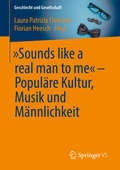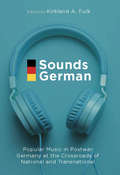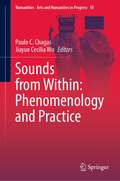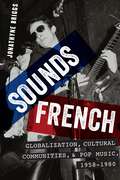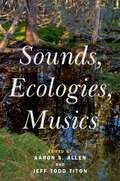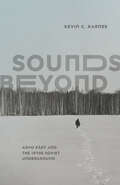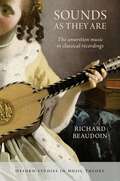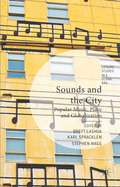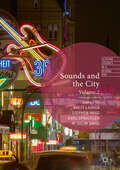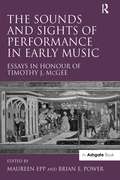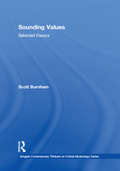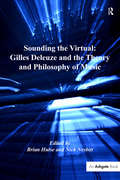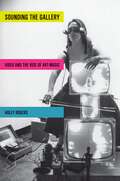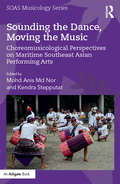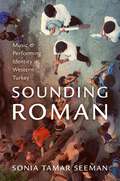- Table View
- List View
„Sounds like a real man to me“ – Populäre Kultur, Musik und Männlichkeit (Geschlecht und Gesellschaft #69)
by Laura Patrizia Fleischer Florian HeeschIn populärer Kultur ist Männlichkeit ein vielschichtiges Thema – hörbar und sichtbar in Sounds, Performances, Medien, Moden, Biographien, Szenen und (Selbst-)Inszenierungen. Was ist Männlichkeit? Zu dieser nicht (mehr) eindeutig zu beantwortenden Frage liefern populäre Musiken, Medien und Szenen diverse Aussagen und Darstellungen, mal eher traditionell, mal eher transgressiv, wobei sich durch Hautfarbe, sexuelle Orientierung, Herkunft oder Behinderung jeweils Bedeutungsverschiebungen ergeben. Anhand vielfältiger populärkultureller Phänomene bietet der Sammelband facettenreiche Einblicke in die aktuelle Männlichkeitsforschung der Geistes-, Kultur- und Sozialwissenschaften.
Sounds in Space, Sounds in Time (PDF): Projects in listening, improvising and composing
by Richard VellaProjects in listening, improvising and composing for secondary school - college level students.
Sounds German: Popular Music in Postwar Germany at the Crossroads of the National and Transnational
by Kirkland A. FulkFor decades, Germany has been shaped and reshaped by the sounds of popular music—whether viewed as uniquely German or an ideological invader from abroad. This collected volume brings together leading figures in the field of German Studies, popular music studies, and cultural studies at large to survey the sociopolitical impact of music on conceptions of the German state and national identity, gender and sexuality, and transnational cultural production and consumption, expanding on the ways in which sounds, technologies, media practices, and exchanges of popular music provide a unique glimpse into the cultural dynamics of postwar Germany.
Sounds from Within: Phenomenology and Practice (Numanities - Arts and Humanities in Progress #18)
by Paulo C. Chagas Jiayue Cecilia WuThis book transforms phenomenology, music, technology, and the cultural arts from within. Gathering contributions by performing artists, media technology designers, nomadic composers, and distinguished musicological scholars, it explores a rich array of concepts such as embodiment, art and technology, mindfulness meditation, time and space in music, self and emptiness, as well as cultural heritage preservation. It does so via close studies on music phenomenology theory, works involving experimental music and technology, and related cultural and historical issues. This book will be of considerable interest to readers from the fields of sound studies, science and technology studies, phenomenology, cultural studies, media studies, and sound art theory. This book is equally relevant and insightful for musicians, composers, media artists, sound artists, technology designers, and curators and arts administrators from the performing and visual arts.
Sounds French: Globalization, Cultural Communities and Pop Music, 1958-1980
by Jonathyne BriggsSounds French examines the history of popular music in France between the arrival of rock and roll in 1958 and the collapse of the first wave of punk in 1980, and the connections between musical genres and concepts of community in French society. During this period, scholars have tended to view the social upheavals associated with postwar reconstruction as part of debates concerning national identity in French culture and politics, a tendency that developed from political figures' and intellectuals' concerns with French national identity. In this book, author Jonathyne Briggs reorients the scholarship away from an exclusive focus on national identity and instead towards an investigation of other identities that develop as a result of the increased globalization of culture. Popular music, at once individual and communal, fixed and plastic, offers an illuminating window into such transformations in social structures through the ways in which musicians, musical consumers, and critical intermediaries re-imagined themselves as part of novel cultural communities, whether local, national, or supranational in nature. Briggs argues that national identity was but one of a panoply of identities in flux during the postwar period in France, demonstrating that the development of hybridized forms of popular music provided the French with a method for expressing and understanding that flux. Drawing upon an array of printed and aural sources, including music publications, sound recordings, record sleeves, biographies, and cultural criticism, Sounds French is an essential new look at popular music in postwar France.
Sounds French: Globalization, Cultural Communities and Pop Music, 1958-1980
by Jonathyne BriggsSounds French examines the history of popular music in France between the arrival of rock and roll in 1958 and the collapse of the first wave of punk in 1980, and the connections between musical genres and concepts of community in French society. During this period, scholars have tended to view the social upheavals associated with postwar reconstruction as part of debates concerning national identity in French culture and politics, a tendency that developed from political figures' and intellectuals' concerns with French national identity. In this book, author Jonathyne Briggs reorients the scholarship away from an exclusive focus on national identity and instead towards an investigation of other identities that develop as a result of the increased globalization of culture. Popular music, at once individual and communal, fixed and plastic, offers an illuminating window into such transformations in social structures through the ways in which musicians, musical consumers, and critical intermediaries re-imagined themselves as part of novel cultural communities, whether local, national, or supranational in nature. Briggs argues that national identity was but one of a panoply of identities in flux during the postwar period in France, demonstrating that the development of hybridized forms of popular music provided the French with a method for expressing and understanding that flux. Drawing upon an array of printed and aural sources, including music publications, sound recordings, record sleeves, biographies, and cultural criticism, Sounds French is an essential new look at popular music in postwar France.
Sounds, Ecologies, Musics
by Aaron S. Allen and Jeff Todd TitonSounds, Ecologies, Musics poses exciting challenges and provides fresh opportunities for scholars, scientists, environmental activists, musicians, and listeners to consider music and sound from ecological standpoints. Authors in Part I examine the natural and built environment and how music and sound are woven into it, how the environment enables music and sound, and how the natural and cultural production of music and sound in turn impact the environment. In Part II, contributors consider music and sound in relation to ecological knowledges that appear to conflict with, yet may be viewed as complementary to, Western science: traditional and Indigenous ecological and environmental knowledges. Part III features multidisciplinary and interdisciplinary approaches by scholars, scientists, and practitioners who probe the ecological imaginary regarding the complex ideas and contested keywords that characterize ecomusicology: sound, music, culture, society, environment, and nature. A common theme across the book is the idea of diverse ecologies. Once confined to the natural sciences, the word "ecology" is common today in the social sciences, humanities, and arts - yet its diverse uses have become imprecise and confusing. Engaging the conflicting and complementary meanings of "ecology" requires embracing a both/and approach. Diverse ecologies are illustrated in the methodological, terminological, and topical variety of the chapters as well as the contributors' choice of sources and their disciplinary backgrounds. In times of mounting human and planetary crises, Sounds, Ecologies, Musics challenges disciplinarity and broadens the interdisciplinary field of ecomusicologies. These theoretical and practical studies expand sonic, scholarly, and political activism from the diversity-equity-inclusion agenda of social justice to embrace the more diverse and inclusive agenda of ecocentric ecojustice.
Sounds, Ecologies, Musics
Sounds, Ecologies, Musics poses exciting challenges and provides fresh opportunities for scholars, scientists, environmental activists, musicians, and listeners to consider music and sound from ecological standpoints. Authors in Part I examine the natural and built environment and how music and sound are woven into it, how the environment enables music and sound, and how the natural and cultural production of music and sound in turn impact the environment. In Part II, contributors consider music and sound in relation to ecological knowledges that appear to conflict with, yet may be viewed as complementary to, Western science: traditional and Indigenous ecological and environmental knowledges. Part III features multidisciplinary and interdisciplinary approaches by scholars, scientists, and practitioners who probe the ecological imaginary regarding the complex ideas and contested keywords that characterize ecomusicology: sound, music, culture, society, environment, and nature. A common theme across the book is the idea of diverse ecologies. Once confined to the natural sciences, the word "ecology" is common today in the social sciences, humanities, and arts - yet its diverse uses have become imprecise and confusing. Engaging the conflicting and complementary meanings of "ecology" requires embracing a both/and approach. Diverse ecologies are illustrated in the methodological, terminological, and topical variety of the chapters as well as the contributors' choice of sources and their disciplinary backgrounds. In times of mounting human and planetary crises, Sounds, Ecologies, Musics challenges disciplinarity and broadens the interdisciplinary field of ecomusicologies. These theoretical and practical studies expand sonic, scholarly, and political activism from the diversity-equity-inclusion agenda of social justice to embrace the more diverse and inclusive agenda of ecocentric ecojustice.
Sounds Beyond: Arvo Pärt and the 1970s Soviet Underground
by Kevin C. KarnesSounds Beyond charts the origins of Arvo Pärt’s most famous music, which was created in dialogue with underground creative circles in the USSR. In Sounds Beyond, Kevin C. Karnes studies the interconnected alternative music and art scenes in the USSR during the second half of the 1970s, revealing the audacious origins of some of Estonian composer Arvo Pärt’s most famous music. Karnes shows how Pärt’s work was created within a vital yet forgotten culture of collective experimentation, the Soviet underground. Mining archives and oral history from across the former USSR, Sounds Beyond carefully situates modes of creative experimentation within their late socialist contexts. In documenting Pärt’s work, Karnes reveals the rich creative culture that thrived covertly in the USSR and the network of figures that made underground performances possible: students, audio engineers, sympathetic administrators, star performers, and aspiring DJs. Sounds Beyond advances a new understanding of Pärt’s music as an expression of the aesthetic and religious commitments shared, nurtured, and celebrated by many in Soviet underground circles. At the same time, this story attests to the lasting power of Pärt’s music. Dislodging the mythology of the solitary creative genius, Karnes shows that Pärt’s work would be impossible without community.
Sounds Beyond: Arvo Pärt and the 1970s Soviet Underground
by Kevin C. KarnesSounds Beyond charts the origins of Arvo Pärt’s most famous music, which was created in dialogue with underground creative circles in the USSR. In Sounds Beyond, Kevin C. Karnes studies the interconnected alternative music and art scenes in the USSR during the second half of the 1970s, revealing the audacious origins of some of Estonian composer Arvo Pärt’s most famous music. Karnes shows how Pärt’s work was created within a vital yet forgotten culture of collective experimentation, the Soviet underground. Mining archives and oral history from across the former USSR, Sounds Beyond carefully situates modes of creative experimentation within their late socialist contexts. In documenting Pärt’s work, Karnes reveals the rich creative culture that thrived covertly in the USSR and the network of figures that made underground performances possible: students, audio engineers, sympathetic administrators, star performers, and aspiring DJs. Sounds Beyond advances a new understanding of Pärt’s music as an expression of the aesthetic and religious commitments shared, nurtured, and celebrated by many in Soviet underground circles. At the same time, this story attests to the lasting power of Pärt’s music. Dislodging the mythology of the solitary creative genius, Karnes shows that Pärt’s work would be impossible without community.
Sounds as They Are: The unwritten music in classical recordings (Oxford Studies in Music Theory)
by Richard BeaudoinIn a recording, what sounds count as music? Sounds made by a musician's body--including inhales, finger taps, and grunts--have for decades been dismissed as extraneous noises. In Sounds as They Are: The unwritten music in classical recordings, author Richard Beaudoin pioneers a field of inquiry into non-notated sounds in recordings of classical music, recognizing often-overlooked sounds made by the bodies of performers and their recording equipment as music. Beaudoin classifies such sounds via inclusive track analysis (ITA), a bold new theory based on a comprehensive census of audible events on a given recording, and then codifies their musical function. He builds a typology across four large categories: sounds of breath (inhaling and exhaling), sounds of touch (guitar squeaks, piano pedals), sounds of effort (grunting and moaning), and surface noise (on early recording formats). Breaths are shown to be as complex and diverse as chords. Touch sounds create empathy with listeners. Effortful vocalizations reveal connections between music-making and sex. The measurement of surface noise reveals moments of synchronization with the meter of the recorded piece. He draws analogies between unwritten music and painting, photography, poetry, psychology, and government. The book's methodology is intertwined with the aesthetics and ethics of non-notated sounds: who is allowed to make them, and how they are received by listeners, critics, and scholars. Beaudoin uncovers insidious inequalities across music studies and the recording industry, including the silencing of body and breath sounds along lines of gender and race. Sounds as They Are demonstrates the expressive, interpretive, and embodied possibilities that emerge when all sounds are valued coequally and asks music theory to face a simple truth: that all sounds deserve recognition.
Sounds as They Are: The unwritten music in classical recordings (Oxford Studies in Music Theory)
by Richard BeaudoinIn a recording, what sounds count as music? Sounds made by a musician's body--including inhales, finger taps, and grunts--have for decades been dismissed as extraneous noises. In Sounds as They Are: The unwritten music in classical recordings, author Richard Beaudoin pioneers a field of inquiry into non-notated sounds in recordings of classical music, recognizing often-overlooked sounds made by the bodies of performers and their recording equipment as music. Beaudoin classifies such sounds via inclusive track analysis (ITA), a bold new theory based on a comprehensive census of audible events on a given recording, and then codifies their musical function. He builds a typology across four large categories: sounds of breath (inhaling and exhaling), sounds of touch (guitar squeaks, piano pedals), sounds of effort (grunting and moaning), and surface noise (on early recording formats). Breaths are shown to be as complex and diverse as chords. Touch sounds create empathy with listeners. Effortful vocalizations reveal connections between music-making and sex. The measurement of surface noise reveals moments of synchronization with the meter of the recorded piece. He draws analogies between unwritten music and painting, photography, poetry, psychology, and government. The book's methodology is intertwined with the aesthetics and ethics of non-notated sounds: who is allowed to make them, and how they are received by listeners, critics, and scholars. Beaudoin uncovers insidious inequalities across music studies and the recording industry, including the silencing of body and breath sounds along lines of gender and race. Sounds as They Are demonstrates the expressive, interpretive, and embodied possibilities that emerge when all sounds are valued coequally and asks music theory to face a simple truth: that all sounds deserve recognition.
Sounds and the City: Popular Music, Place and Globalization (Leisure Studies in a Global Era)
by Stephen Wagg Karl Spracklen Brett LashuaThis book explores the ways in which Western-derived music connects with globalization, hybridity, consumerism and the flow of cultures. Both as local terrain and as global crossroads, cities remain fascinating spaces of cultural contestation and meaning-making via the composing, playing, recording and consumption of popular music.
Sounds and the City: Volume 2 (Leisure Studies in a Global Era)
by Stephen Wagg Karl Spracklen Brett Lashua M. Selim YavuzThis book draws from a rich history of scholarship about the relations between music and cities, and the global flows between music and urban experience. The contributions in this collection comment on the global city as a nexus of moving people, changing places, and shifting social relations, asking what popular music can tell us about cities, and vice versa. Since the publication of the first Sounds and the City volume, various movements, changes and shifts have amplified debates about globalization. From the waves of people migrating to Europe from the Syrian civil war and other conflict zones, to the 2016 “Brexit” vote to leave the European Union and American presidential election of Donald Trump. These, and other events, appear to have exposed an anti-globalist retreat toward isolationism and a backlash against multiculturalism that has been termed “post-globalization.” Amidst this, what of popular music? Does music offer renewed spaces and avenues for public protest, for collective action and resistance? What can the diverse histories, hybridities, and legacies of popular music tell us about the ever-changing relations of people and cities?
The Sounds and Sights of Performance in Early Music: Essays in Honour of Timothy J. McGee
by Maureen Ep Brian E. PowerThe experience of music performance is always far more than the sum of its sounds, and evidence for playing and singing techniques is not only inscribed in music notation but can also be found in many other types of primary source materials. This volume of essays presents a cross-section of new research on performance issues in music of the Middle Ages and Renaissance. The subject is approached from a broad perspective, drawing on areas such as dance history, art history, music iconography and performance traditions from beyond Western Europe. In doing so, the volume continues some of the many lines of inquiry pursued by its dedicatee, Timothy J. McGee, over a lifetime of scholarship devoted to practical questions of playing and singing early music. Expanding the bases of inquiry to include various social, political, historical or aesthetic backgrounds both broadens our knowledge of the issues pertinent to early music performance and informs our understanding of other cultural activities within which music played an important role. The book is divided into two parts: 'Viewing the Evidence' in which visually based information is used to address particular questions of music performance; and 'Reconsidering Contexts' in which diplomatic, commercial and cultural connections to specific repertories or compositions are considered in detail. This book will be of value not only to specialists in early music but to all scholars of the Middle Ages and Renaissance whose interests intersect with the visual, aural and social aspects of music performance.
The Sounds and Sights of Performance in Early Music: Essays in Honour of Timothy J. McGee
by BrianE. PowerThe experience of music performance is always far more than the sum of its sounds, and evidence for playing and singing techniques is not only inscribed in music notation but can also be found in many other types of primary source materials. This volume of essays presents a cross-section of new research on performance issues in music of the Middle Ages and Renaissance. The subject is approached from a broad perspective, drawing on areas such as dance history, art history, music iconography and performance traditions from beyond Western Europe. In doing so, the volume continues some of the many lines of inquiry pursued by its dedicatee, Timothy J. McGee, over a lifetime of scholarship devoted to practical questions of playing and singing early music. Expanding the bases of inquiry to include various social, political, historical or aesthetic backgrounds both broadens our knowledge of the issues pertinent to early music performance and informs our understanding of other cultural activities within which music played an important role. The book is divided into two parts: 'Viewing the Evidence' in which visually based information is used to address particular questions of music performance; and 'Reconsidering Contexts' in which diplomatic, commercial and cultural connections to specific repertories or compositions are considered in detail. This book will be of value not only to specialists in early music but to all scholars of the Middle Ages and Renaissance whose interests intersect with the visual, aural and social aspects of music performance.
Sounding Values: Selected Essays (Ashgate Contemporary Thinkers on Critical Musicology Series)
by Scott BurnhamFor several decades, Scott Burnham has sought to bring a ready ear and plenty of humanistic warmth to musicological inquiry. Sounding Values features eighteen of his essays on mainstream Western music, music theory, aesthetics and criticism. In these writings, Burnham listens for the values-aesthetic, ethical, intellectual-of those who have created influential discourse about music, while also listening for the values of the music for which that discourse has been generated. The first half of the volume confronts pressing issues of historical theory and aesthetics, including intellectual models of tonal theory, leading concepts of sonata form, translations of music into poetic meaning, and recent rifts and rapprochements between criticism and analysis. The essays in the second half can be read as a series of critical appreciations, engaging some of the most consequential reception tropes of the past two centuries: Haydn and humor, Mozart and beauty, Beethoven and the sublime, Schubert and memory.
Sounding Values: Selected Essays (Ashgate Contemporary Thinkers on Critical Musicology Series)
by Scott BurnhamFor several decades, Scott Burnham has sought to bring a ready ear and plenty of humanistic warmth to musicological inquiry. Sounding Values features eighteen of his essays on mainstream Western music, music theory, aesthetics and criticism. In these writings, Burnham listens for the values-aesthetic, ethical, intellectual-of those who have created influential discourse about music, while also listening for the values of the music for which that discourse has been generated. The first half of the volume confronts pressing issues of historical theory and aesthetics, including intellectual models of tonal theory, leading concepts of sonata form, translations of music into poetic meaning, and recent rifts and rapprochements between criticism and analysis. The essays in the second half can be read as a series of critical appreciations, engaging some of the most consequential reception tropes of the past two centuries: Haydn and humor, Mozart and beauty, Beethoven and the sublime, Schubert and memory.
Sounding the Virtual: Gilles Deleuze and the Theory and Philosophy of Music
by Nick NesbittIt is the contention of the editors and contributors of this volume that the work carried out by Gilles Deleuze, where rigorously applied, has the potential to cut through much of the intellectual sedimentation that has settled in the fields of music studies. Deleuze is a vigorous critic of the Western intellectual tradition, calling for a 'philosophy of difference', and, despite its ambitions, he is convinced that Western philosophy fails to truly grasp (or think) difference as such. It is argued that longstanding methods of conceptualizing music are vulnerable to Deleuze's critique. But, as Deleuze himself stresses, more important than merely critiquing established paradigms is developing ways to overcome them, and by using Deleuze's own concepts this collection aims to explore that possibility.
Sounding the Virtual: Gilles Deleuze and the Theory and Philosophy of Music
by Nick NesbittIt is the contention of the editors and contributors of this volume that the work carried out by Gilles Deleuze, where rigorously applied, has the potential to cut through much of the intellectual sedimentation that has settled in the fields of music studies. Deleuze is a vigorous critic of the Western intellectual tradition, calling for a 'philosophy of difference', and, despite its ambitions, he is convinced that Western philosophy fails to truly grasp (or think) difference as such. It is argued that longstanding methods of conceptualizing music are vulnerable to Deleuze's critique. But, as Deleuze himself stresses, more important than merely critiquing established paradigms is developing ways to overcome them, and by using Deleuze's own concepts this collection aims to explore that possibility.
Sounding the Gallery: Video and the Rise of Art-Music (Oxford Music / Media)
by Holly RogersBecoming commercially available in the mid 1960s, video quickly became integral to the intense experimentalism of New York City's music and art scenes. The medium was able to record image and sound at the same time, which allowed composers to visualize their music and artists to sound their images. But as well as creating unprecedented forms of audiovisuality, video work also producedinteractive spaces that questioned conventional habits of music and art consumption. This book explores the first decade of creative video work, focusing on the ways in which video technology was used to dissolve the boundaries between art and music.
Sounding the Gallery: Video and the Rise of Art-Music (Oxford Music / Media)
by Holly RogersBecoming commercially available in the mid 1960s, video quickly became integral to the intense experimentalism of New York City's music and art scenes. The medium was able to record image and sound at the same time, which allowed composers to visualize their music and artists to sound their images. But as well as creating unprecedented forms of audiovisuality, video work also producedinteractive spaces that questioned conventional habits of music and art consumption. This book explores the first decade of creative video work, focusing on the ways in which video technology was used to dissolve the boundaries between art and music.
Sounding the Dance, Moving the Music: Choreomusicological Perspectives on Maritime Southeast Asian Performing Arts (SOAS Studies in Music Series)
by Mohd Anis Nor Kendra StepputatPerforming arts in most parts of Maritime Southeast Asia are seen as an entity, where music and dance, sound and movement, acoustic and tactile elements intermingle and complement each other. Although this fact is widely known and referenced, most scholarly works in the performing arts so far have either focused on "music" or "dance" rather than treating the two in combination. The authors in this book look at both aspects in performance, moreover, they focus explicitly on the interrelation between the two, on both descriptive-analytical and metaphorical levels. The book includes diverse examples of regional performing art genres from Indonesia, Malaysia and the Philippines. All case studies are composed from the perspective of the relatively new approach and field of ethno-choreomusicology. This particular compilation gives an exemplary overview of various phenomena in movement-sound relations, and offers for the first time a thorough study of the phenomenon that is considered essential for the performing arts in Maritime Southeast Asia - the inseparability of movement and sound.
Sounding the Dance, Moving the Music: Choreomusicological Perspectives on Maritime Southeast Asian Performing Arts (SOAS Studies in Music Series)
by Kendra Stepputat Mohd Anis Md NorPerforming arts in most parts of Maritime Southeast Asia are seen as an entity, where music and dance, sound and movement, acoustic and tactile elements intermingle and complement each other. Although this fact is widely known and referenced, most scholarly works in the performing arts so far have either focused on "music" or "dance" rather than treating the two in combination. The authors in this book look at both aspects in performance, moreover, they focus explicitly on the interrelation between the two, on both descriptive-analytical and metaphorical levels. The book includes diverse examples of regional performing art genres from Indonesia, Malaysia and the Philippines. All case studies are composed from the perspective of the relatively new approach and field of ethno-choreomusicology. This particular compilation gives an exemplary overview of various phenomena in movement-sound relations, and offers for the first time a thorough study of the phenomenon that is considered essential for the performing arts in Maritime Southeast Asia - the inseparability of movement and sound.
SOUNDING ROMAN C: Representation and Performing Identity in Western Turkey
by Sonia Tamar SeemanHow do marginalized communities speak back to power when they are excluded from political processes and socially denigrated? In what ways do they use music to sound out their unique histories and empower themselves? How can we hear their voices behind stereotyped and exaggerated portrayals promoted by mainstream communities, record producers and government officials? Sounding Roman: Music and Performing Identity in Western Turkey explores these questions through a historically-grounded and ethnographic study of Turkish Roman ("Gypsies") from the Ottoman period up to the present. Drawing on extensive ethnographic fieldwork (1995 to the present), collected oral histories, historical documents of popular culture (recordings, images, song texts, theatrical scripts), legal and administrative documents, this book takes a hard look at historical processes by which Roman are stereotyped as and denigrated as "çingene"---a derogatory group name equivalent to the English term, "gypsy", and explores creative musical ways by which Roman have forged new musical forms as a means to create and assert new social identities. Sounding Roman presents detailed musical analysis of Turkish Roman musical genres and styles, set within social, historical and political contexts of musical performances. By moving from Byzantine and Ottoman social contexts, we witness the reciprocal construction of ethnic identity of both Roman and Turk through music in the 20th century. From neighborhood weddings held in the streets, informal music lessons, to recording studios and concert stages, the book traces the dynamic negotiation of social identity with new musical sounds. Through a detailed ethnography of Turkish Roman ("Gypsy") musical practices from the Ottoman period to the present, this work investigates the power of music to configure new social identities and pathways for political action, while testing the limits of cultural representation to effect meaningful social change.
